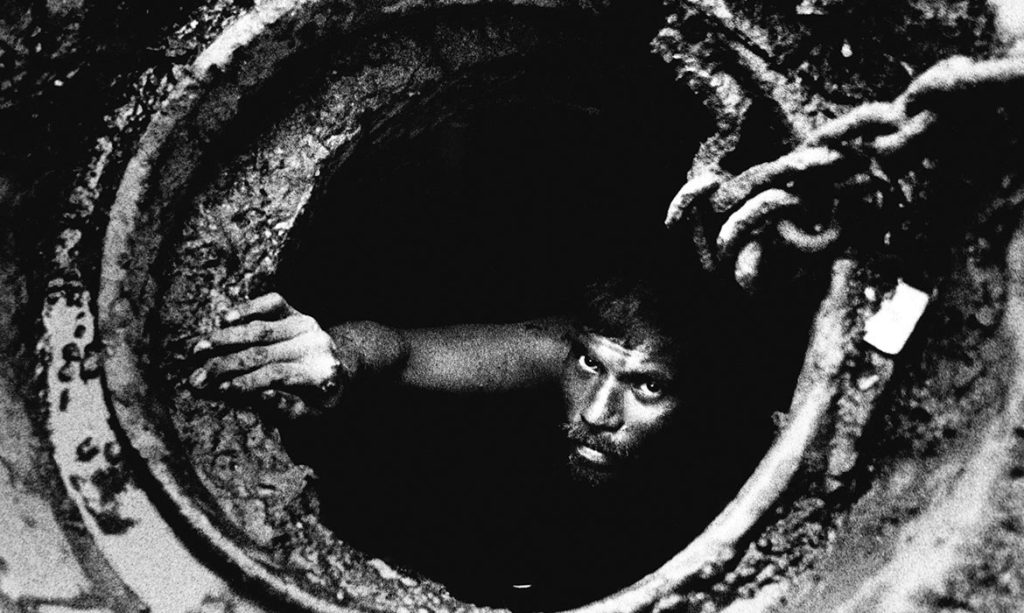Saptarshi Ghosh
Dalit History Month, which is observed every year in the month of April, is meant to recognise and celebrate the struggles and achievements of Dalit communities across the world. It was first observed in 2015 by a group of young Dalit women, including Sanghapali Aruna and Thenmozhi Soundararajan. However, the idea of a Dalit History Month, inspired from Black History Month, was first posited by the Tamil Dalit activist Paari Chezhian in a 2011 blogpost. During this month, various events, like seminars, art exhibitions, poetry festivals and so on, throw the spotlight on contributions made by Dalits, Adivasis and Bahujans, while also underlining the systemic forces of Brahminical oppression that subjugate them, alienate them from mainstream society and rob them of basic dignity and respect.
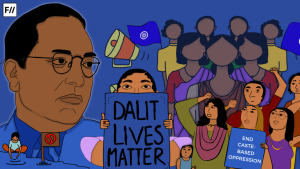
Courtesy- Feminism in India
Even 75 years after Independence, the spectre of casteism continues to haunt Indian society. Lynchings, rape and other atrocities continue to be perpetrated on members of Dalit communities. Contrary to the claims of apologists and reactionary voices, who deny the existence of caste-based inequalities, lower-caste groups continue to be marginalised in all avenues of social life. Recent demographic studies have shown how those belonging to Scheduled Caste (SC) and Scheduled Tribe (ST) groups, unlike upper-caste citizens, mostly remain relegated to spaces lacking access to basic civic amenities. Majority of Dalits still find it difficult to obtain a decent education or pursue a career at par with their privileged Savarna counterparts. It is no surprise that the premier educational institutions and workspaces in the country have become spaces almost exclusive for upper-caste groups. And among the lucky few who do make it to these spaces, mental abuse and experiences of alienation are not uncommon.
This Dalit History Month, let’s take a look at some important artists who have attacked casteism and caste-based discrimination through their art.
Savindra Sawarkar
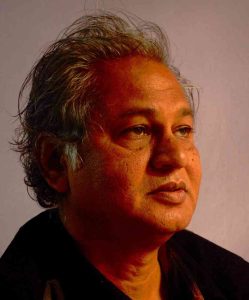
Courtesy- Scroll
Savindra ‘Savi’ Sawarkar is probably the first Bahujan artist to have explored Dalit experiences of caste in elite gallery spaces in India. Born in 1961 to a family belonging to Mahar caste in Nagpur, Sawarkar’s visual aesthetic draws from Ambedkarite philosophy and neo-Buddhist imagery to authentically convey Dalit subjectivities, while subverting dominant caste perspectives. Sawarkar was inclined towards painting from a very young age. After studying fine arts at Chitrakala Mahavidyalaya in his hometown, he pursued an MFA in Printmaking from MS University Baroda. Sawarkar has also collaborated with stalwarts like Krishnan Reddy at the Lalit Kala Akademi’s Garhi studios and K. G. Subramanyan at Shantiniketan.
Sawarkar’s work on devadasis is significant. Receiving the Garhi grant, he decided to document the exploitation of Dalit girls who would be forced to serve as devadasis at the Yellamma temple in Saundatti, Karnataka. He even took on the disguise of a mute priest to observe life in the temple – a very risky venture which would have cost him his life if his caste identity ever got exposed. His experiences at the Yellamma temple shocked him to the core.
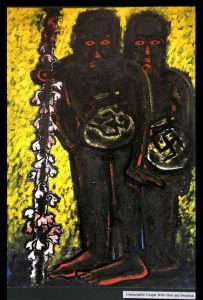
Courtesy- Scroll
Sawarkar’s expressive canvases are replete with references to lived experiences of exclusion and discrimination that Dalits have faced throughout history. In his oil painting Untouchable Couple with Om and Swastika, two untouchable figures are shown carrying a clay pot each – inscribed on one of them is the sacred Hindu sign of Om, while the other bears the symbol of the (caste-Hindu) Swastika. Sawarkar alludes to the age-old tradition wherein untouchables were forced to carry clay pots to spit into so that their saliva would not fall on the ground and accidentally pollute an upper-caste person. The figure in front carries a stick with bells: this references the tradition in which lower-caste people would carry a bell to announce their approach so that caste-Hindus could move away from their impending shadows.
Commenting on how closely his art is interlinked with Dalit politics, he says the following which aptly sums up his artistic philosophy: “Politics and aesthetics are not separate from each other but are interconnected. You work on all issues simultaneously because there is an internal logic binding them. Inevitably, one subject contains another.”
Sudharak Olwe
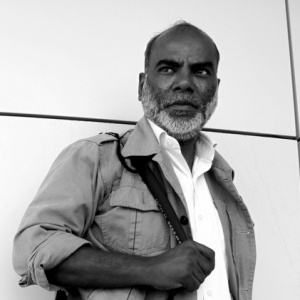
Courtesy- Blink Network
Sudharak Olwe is a renowned photojournalist based out of Mumbai, whose incredibly powerful photographs narrate invigorating stories of courage and resilience in face of extreme adversity. Olwe’s images in stark black-and-white force us to confront pressing issues of the time that we conveniently choose to ignore – from drawing attention to the plight of sweepers in Mumbai to documenting the lives of prostitutes in Kamathipura, Olwe always amplifies the voices of marginalised people. In 2016, he was awarded the Padma Shri for his commitment to social justice.
Olwe has also gained international recognition for his images documenting the lives of Dalit people. Olwe’s photographs provide a window into the everyday experiences of Dalit communities and challenge the dominant narrative of the caste system in India. His series Justice Delayed is Justice Denied documents disturbing stories of caste-based atrocities perpetrated on Dalits in rural Maharashtra. In his project with the NGO WaterAid, titled Including the Excluded, he has chronicled the struggles of manual scavengers and sanitation workers across the country, whose Dalit identities force them to perform such inhumane jobs.
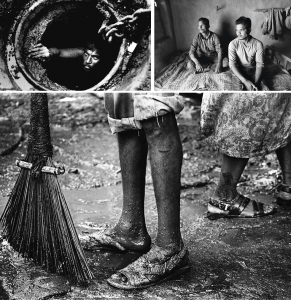
Courtesy- www.sudharakolwe.com
For Olwe, Dalit art involves “essentially challenging a system and creating a space for itself as part of democratic equality and contemporary expressions”. He uses photography as a tool in his quest for a more just and egalitarian society. “Photography for me has been a way to explore and communicate ideas that are an impetus to bring about social change in neglected and marginalised communities,” he explains. “My genre of work involves making visible those realities that existed around us, but remained invisible in Indian society. I come from a social strata that is looked down on and discriminated against in my country; the camera has been my companion and resort.”
Prabhakar Kamble
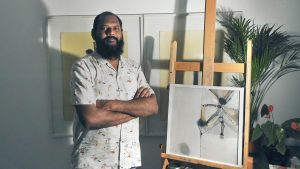
Courtesy- India Art Fair
Prabhakar Kamble is a Mumbai-based conceptual artist whose works address caste-based hierarchies and systemic modes of discrimination. He also works as a curator and a cultural activist. Born to a poor family in rural Maharashtra, Kamble encountered tremendous odds in his journey to being an artist. After completing a diploma in art education from L. S. Raheja School of Art, Mumbai, he enrolled for a post graduate diploma from the prestigious Sir J. J. School of Art in 2013.
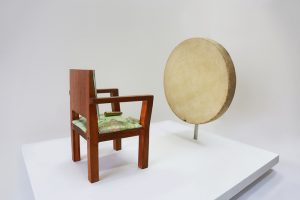
Courtesy- The Showroom
Through his art, Kamble attacks people in positions of power for their complicity in the persistence of caste-based fault lines in society. Whenever people raise their voices for causes that go against the ruling elite, they are muzzled with impunity. Kamble’s 2017 work Suppressive convincingly tackles this theme. For this piece, he placed a wooden chair with an image of the world map printed on its seat. Placed on the seat was a bullet aimed at a large tambourine hanging nearby.
Utarand (2022) is another layered piece of sculptural work by Kamble. He has used metal casts of the feet of agricultural workers to stack multiple terracotta pots on top of each other, in order of their sizes. Such pots are traditionally used to store food and grains in every home. The pots get smaller in size, which represents the societal hierarchy engendered by the caste system: the higher
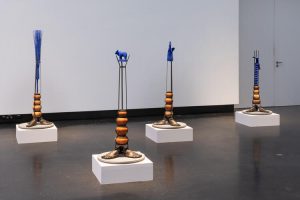
Courtesy- Frieze
rungs of the social strata are occupied by the minority Savarnas, who possess the most wealth; the lower-caste majority, on the other hand, is shorn off all dignity and respect and consigned to a permanent state of exclusion and deprivation. The pots are also meant to evoke the terracotta urns containing the ashes of Dalits, who have fallen victim to lynchings and other atrocities. Each vertical structure ends with a symbol of dehumanisation at the summit — a cow (whose life is considered more worthy than that of a human), a sweeper’s broom or a sanitation worker’s gloves. Moreover, Kamble’s use of the blue colour is significant for it is emblematic of Ambedkarite movements.
Speaking on his artistic motivations, Kamble says, “I explore the idea of suppression. The ruling party changes but the ruling class remains the same. I have inherited the struggle and I carry the burden. […] This is my art and I will not betray my struggle.”
Rajyashri Goody

Courtesy- Ishara Art Foundation
Rajyashri Goody is a Pune-based contemporary artist whose work explores the intersections of caste, gender and identity. Influenced by everyday and historical instances of Dalit resistance, Goody’s works highlight how the Dalit identity is being reclaimed and reinvented through apparently benign acts, like sharing a meal or drinking water from the same well, that subvert rigid social norms. Her vision is also shaped by her academic background in sociology and visual anthropology.
Goody’s practice is informed by her research in Dalit literary and photo archives. She expands upon this research with writings of her own as well as her sculptural works in ceramic and paper. She even incorporates found objects or other people’s belongings in her works.

Courtesy- www.rajyashrigoody.com
Consider her powerful 2015 installation work Skyscape, which was conceptualised as a tangible representation of the Hindu varna system propounded by the ancient Hindu text Manusmriti. Every caste, as per the scriptures, represents a part of the body. In this hierarchy, the lower-caste shudras occupied a position below the feet of the human body. As part of the work, Goody strung together 500 pairs of slippers and hung them from the ceiling. The colossal, entangled mass of slippers elicited varying responses from viewers – while some felt claustrophobic, others considered it to be unclean.
Goody has shown at esteemed galleries and exhibitions that include Clark House Initiative in Mumbai, Pulp Society in New Delhi, Devi Art Foundation in New Delhi and Serendipity Arts Festival in Goa, to name a few.
Bibliography:
- https://feminisminindia.com/2023/04/01/dalit-history-month-mood-of-the-month-april-2023/
- https://en.wikipedia.org/wiki/Dalit_History_Month
- https://scroll.in/magazine/1033348/in-all-my-years-no-gallery-has-represented-me-savindra-sawarkar-on-brahmanism-in-the-arts
- https://www.thebeacon.in/2019/01/30/unsettling-art-caste-gender-dalit-expression/
- https://www.dailyo.in/arts/padma-shri-photographer-sudharak-olwe-dalits-art-farmers-oppression-28578
- https://www.sudharakolwe.com/sanitation-workers.html
- https://www.sudharakolwe.com/justicedenied.html
- https://www.theshowroom.org/relationships/prabhakar-kamble
- https://12.berlinbiennale.de/artists/prabhakar-kamble/
- https://www.indiatoday.in/lifestyle/people/story/dalit-artist-prabhakar-kamble-talks-about-the-politics-of-identity-1343955-2018-09-19
- https://homegrown.co.in/homegrown-voices/5-works-of-art-that-are-challenging-indias-caste-barriers
- https://www.rijksakademie.nl/en/residents-advisors-team/rajyashri-goody

